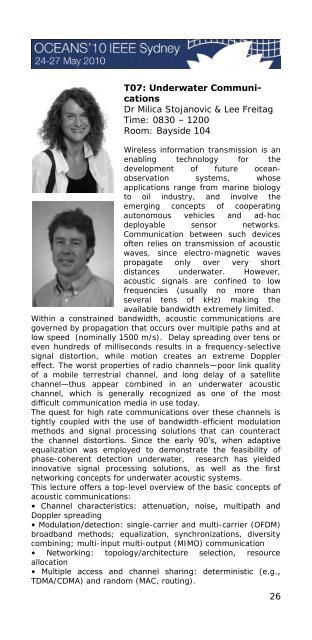Program Book - Oceans'10 IEEE Sydney
Program Book - Oceans'10 IEEE Sydney
Program Book - Oceans'10 IEEE Sydney
Create successful ePaper yourself
Turn your PDF publications into a flip-book with our unique Google optimized e-Paper software.
T07: Underwater Communications<br />
Dr Milica Stojanovic & Lee Freitag<br />
Time: 0830 – 1200<br />
Room: Bayside 104<br />
Wireless information transmission is an<br />
enabling technology for the<br />
development of future oceanobservation<br />
systems, whose<br />
applications range from marine biology<br />
to oil industry, and involve the<br />
emerging concepts of cooperating<br />
autonomous vehicles and ad-hoc<br />
deployable sensor networks.<br />
Communication between such devices<br />
often relies on transmission of acoustic<br />
waves, since electro-magnetic waves<br />
propagate only over very short<br />
distances underwater. However,<br />
acoustic signals are confined to low<br />
frequencies (usually no more than<br />
several tens of kHz) making the<br />
available bandwidth extremely limited.<br />
Within a constrained bandwidth, acoustic communications are<br />
governed by propagation that occurs over multiple paths and at<br />
low speed (nominally 1500 m/s). Delay spreading over tens or<br />
even hundreds of milliseconds results in a frequency-selective<br />
signal distortion, while motion creates an extreme Doppler<br />
effect. The worst properties of radio channels—poor link quality<br />
of a mobile terrestrial channel, and long delay of a satellite<br />
channel—thus appear combined in an underwater acoustic<br />
channel, which is generally recognized as one of the most<br />
difficult communication media in use today.<br />
The quest for high rate communications over these channels is<br />
tightly coupled with the use of bandwidth-efficient modulation<br />
methods and signal processing solutions that can counteract<br />
the channel distortions. Since the early 90‘s, when adaptive<br />
equalization was employed to demonstrate the feasibility of<br />
phase-coherent detection underwater, research has yielded<br />
innovative signal processing solutions, as well as the first<br />
networking concepts for underwater acoustic systems.<br />
This lecture offers a top-level overview of the basic concepts of<br />
acoustic communications:<br />
• Channel characteristics: attenuation, noise, multipath and<br />
Doppler spreading<br />
• Modulation/detection: single-carrier and multi-carrier (OFDM)<br />
broadband methods; equalization, synchronizations, diversity<br />
combining; multi-input multi-output (MIMO) communication<br />
• Networking: topology/architecture selection, resource<br />
allocation<br />
• Multiple access and channel sharing: deterministic (e.g.,<br />
TDMA/CDMA) and random (MAC, routing).<br />
26


